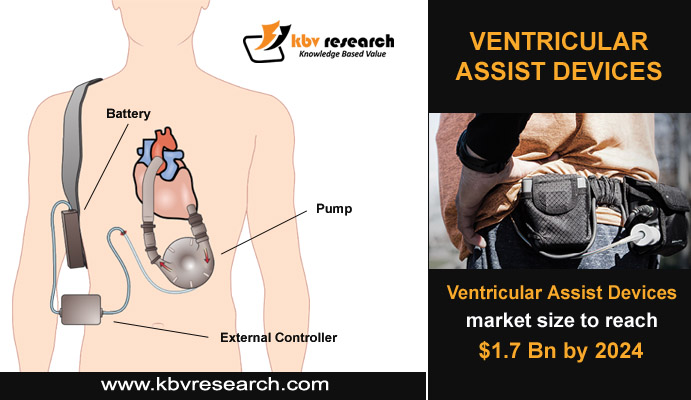
Left ventricular hypertrophy is becoming common in people with high blood pressure. The risk of heart attack and stroke is increasing rapidly because of increased occurrence of left ventricular hypertrophy. The ratio of patients with ventricular diseases is rising alarmingly because of genetic abnormality, cardiomyopathy, structural heart diseases, ischemic heart diseases, heart failure, and many other diseases. In prominent cases, ventricular diseases can even cause a heart to stop which is a life-threatening emergency. Heart failure represents a concerning problem in the pediatric population and according to reports, are causing beyond 10,000 hospitalizations every year. Therefore, there is an urgent need for effective ventricular assist devices.
Ventricular assist devices are implantable mechanical pumps that help in controlling the blood flow from ventricles of heart to the rest of body. These devices imitate the functioning of ventricles and are implanted at the end of heart. These flow pumps are either pulsatile or continuous. The continuous flow pump circulates blood uninterruptedly, while the pulsatile pump mimics the actual heart pulse. The devices are used in people who have weak hearts or heart failure. The device can continuously pump blood despite a diseased heart and can be removed when the new heart is implanted. Additionally, it can help in improving the function of other organs inside a patients body.
The basic parts of a ventricular assist device include a small tube that carries blood out of the heart into a pump; a tube that carries blood from the pump to the blood vessels, and a power source. The power source is attached to a control unit that observes the devices functions.
As per a recent report published by KBV Research, one of the leading market research companies, the aforementioned driving factors are expected to collectively take the global market value of Ventricular Assist Devices up to $1,720.3 million by 2024. The market is expected to perpetually soar at a CAGR of 11.1% over the forecast period.
Although a ventricular assist device can be placed in the left, right, or both ventricles of a patients heart, it is mostly used for the left ventricle as heart problems generally occur more in left arteries. Evidently, left ventricular assist devices are gaining significantly higher prominence in the global healthcare ecosphere. It helps the bottom left chamber of the heart in pumping out blood from the ventricle to the aorta and rest of the body.
Right ventricular assist devices are generally for short-term support of the right ventricle after left ventricular assist device surgery or other heart surgery. RVADs help the right ventricle pump to the pulmonary artery. This artery carries blood to the lungs for picking up oxygen.
Bridge-to-transplant (BTT) Therapy
When a ventricular assist device is implanted while the patient is waiting for a heart transplant, the procedure is referred to as bridge-to-transplant. This application segment exhibits the highest prominence in the current medical scenario. If a patient is awaiting the heart transplant, the BTT therapy helps the patient in surviving until a donors heart becomes available. Ventricular assist devices are placed to the heart and is later removed at the time of transplant.
Destination Therapy
Ventricular assist devices for patients undergoing destination therapy has been approved by the FDA. It is considered for patients when all other treatment options like medications or heart procedures have been tried out. Destination therapy supports a patients heart function and improves the quality of life of a patient.
Trends
Despite advancements in medical and surgical therapies, children suffering from congenital heart disease are unable to get sufficiently treated or palliated which leads them towards progressive heart failure. As these patients progress towards end-stage heart failure, they gather unique set of challenges. Heart transplant consistently remains the standard of care. However, the door pool remains limited. Owing to the experiences of adult realm, pediatric ventricular assist devices are emerging as a suitable treatment option as a bridge to transplant. Advancements in device design, surgical methods, and post-operative management have clearly established ventricular assist devices as a crucial option for treating a challenging group of patients with heart failure. The second-gen devices are including implantable rotary pumps that offer versatile advantages over pulsatile flow pumps. Currently, there is an ongoing trial in the destination therapy patients.